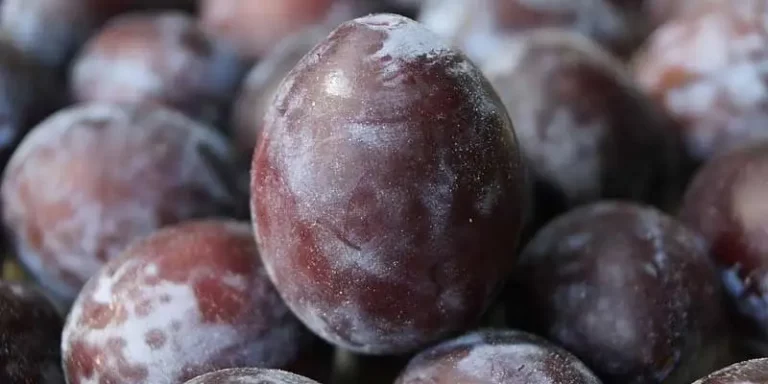If you’ve eaten a plum, you probably peel the skin off it and just eat the fleshy part of the fruit. Since the skin is soft, you may be thinking about trying it next time you eat.
The answer is yes! Plum skin is edible. It’s not only edible, but it’s also quite delicious and nutritous. Plum skin is a little tougher than the flesh of the fruit itself and it has a bit more tannic flavor. But if you’re willing to work with it, you can enjoy the deliciousness of plums without taking off all the skin.
Is Plum Skin Safe To Eat?
Plum skin is edible and safe to eat, but it’s not always pleasant. The texture of the skin can be rubbery and chewy, especially if you have a plum that’s been sitting on the shelf for a while. It’s also tough to peel, though you can cook with the skin on if you prefer.
To get the most out of your plums, make sure they’re ripe before eating them. Ripe plums have a brighter color than unripe ones and are softer to the touch. They also have fewer seeds inside them than unripped plums do.
The best way to tell if a plum is ripe is by smelling it. If it smells sweet like honey, then it’s ready to eat!
Are There Any Benefits To Eating Plum Skin?
Plum skin is rich in dietary fiber, vitamin A and vitamin C. It is also a good source of iron and calcium. Plum skin contains high levels of antioxidants that help fight free radicals in the body.
Below are some of the benefits you can get from eating plum skin:
1. Improves Digestion: It helps to improve digestion by increasing the production of bile, which aids the digestion process.
2. Improves Heart Health: Plum skin contains elements like anthocyanin, which help protect the heart against oxidative stress and other cardiovascular diseases like atherosclerosis and coronary heart disease (CHD).
3. Reduces Inflammation: Plums contain ellagic acid, which is an antioxidant that reduces inflammation by inhibiting NF-kB pathway activity and preventing inflammatory cytokines from being released into the bloodstream by immune cells (macrophages).
4. Keeps Blood Sugar Levels Under Control: The fiber content helps to keep blood sugar levels under control as well as fat absorption by slowing down digestion and absorption of carbohydrates from the intestine into the bloodstream.
What Do Plum Skin Taste Like?
The taste of plum skin varies depending on its variety as some plums taste sweeter than others while some have a tart flavor or even bitter taste.
Overall, plum skins tend to be sweet with a hint of sourness to them. However, if you bite into a sour plum it will leave your mouth feeling puckered up for quite some time!
How To Clean Plum Skin
It’s a very good question because the skin of the plum is very thin and sensitive. It can be easily damaged when you want to peel it off. So, if you want to peel off the skin of your fresh plums, here is how you can do it:
1. Use a sharp knife and cut the plum into halves or quarters. Be careful not to damage the flesh inside.
2. Take one half or quarter and put it inside a bowl of cold water for about 30 minutes or until it softens enough for you to remove its outer skin easily by rubbing gently with your fingers or palms (make sure your hands are wet).
Don’t rub too hard; just enough so that the pulp starts coming out easily from where it has been attached to the rest of the fruit (this will also help to clean any remaining bits of pulp sticking to your fingers).
What Can You Use Plum Skin For?
Plum skin is a wonderful thing. It can be used for flavoring, for tannin, and even for making ink. It’s a shame that most of us probably throw the skin away when we eat plums.
Plum skin contains a lot of tannins, which are compounds that make it hard to digest food and can cause diarrhea or other digestive issues. Luckily, you can use them to make your own tea or as an ingredient in some recipes.
Tannins are also used in tanning leather, which gives it strength and durability. This makes plum skin an excellent way to protect your leather shoes from water damage or rot until they’re ready to be worn again.
If you want to try using plum skins in your home instead of purchasing commercial products, there are plenty of ways to use them around your house!
Related Questions
Can you eat plum seeds?
Yes, you can eat plum seeds, but there are some precautions. The bitter almond flavor of the seeds may not appeal to everyone.
The seeds are also poisonous if they are not cooked or properly prepared. Uncooked plum seeds contain cyanide and should be avoided.
Plum seeds have been used in traditional Chinese medicine for centuries as a treatment for coughs, colds, flu, and diarrhea. They have also been used as an aphrodisiac and to treat impotence.
You can purchase dried plum seeds in health food stores. They may be eaten whole or ground into a powder and added to foods such as cereal, yogurt, or salads
Can you eat plum leaves?
Plum leaves are edible, but they are not commonly eaten. The leaves have a bitter taste, so you may want to boil them or steam them before eating them. This will help reduce their bitterness and make them more palatable.
You can also use the leaves in salads or as a garnish for cooked dishes. They can be used in stir-fries or added to soups and stews. You can also add them to vegetable juices or smoothies for an extra nutritional boost.

